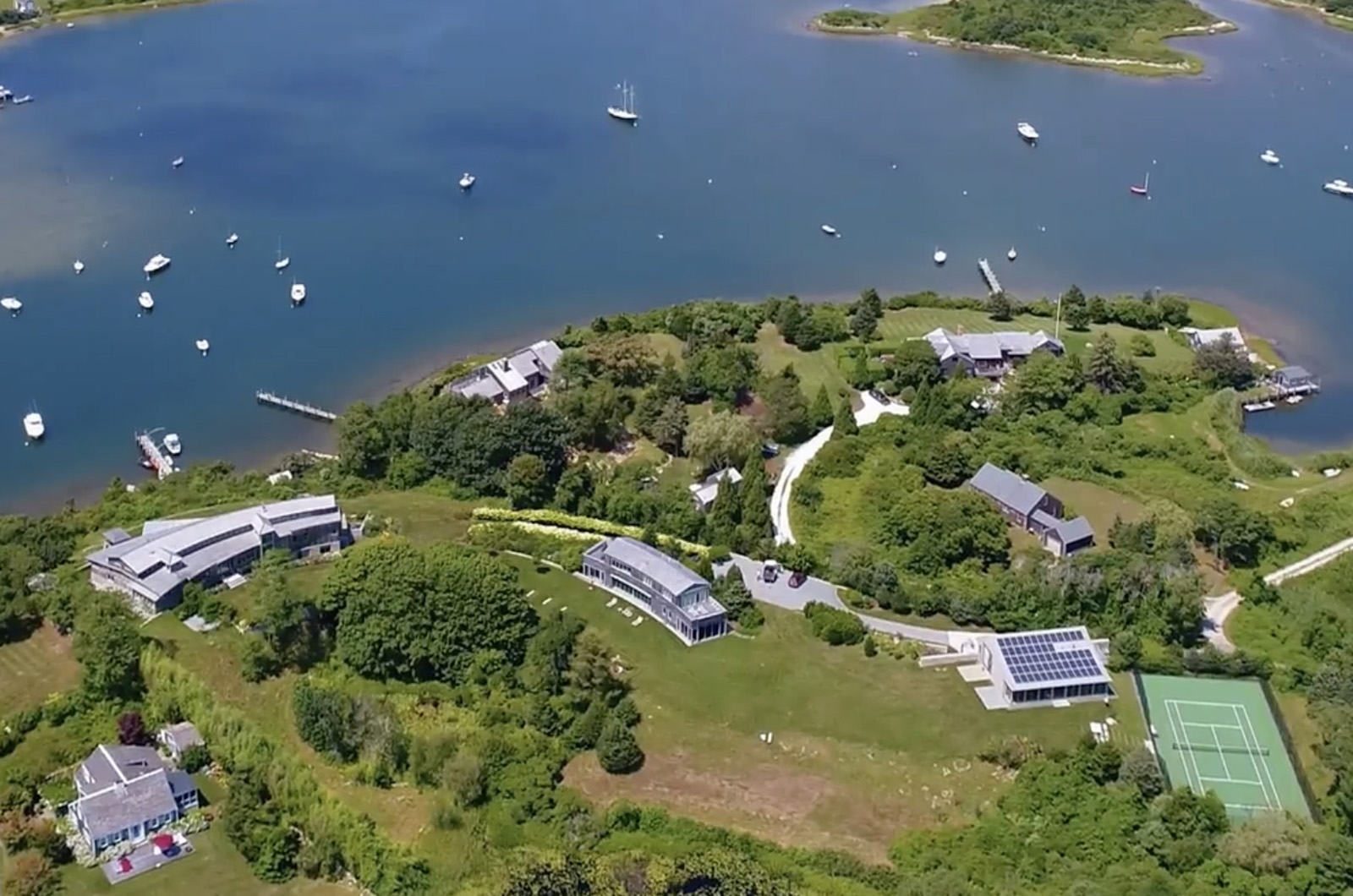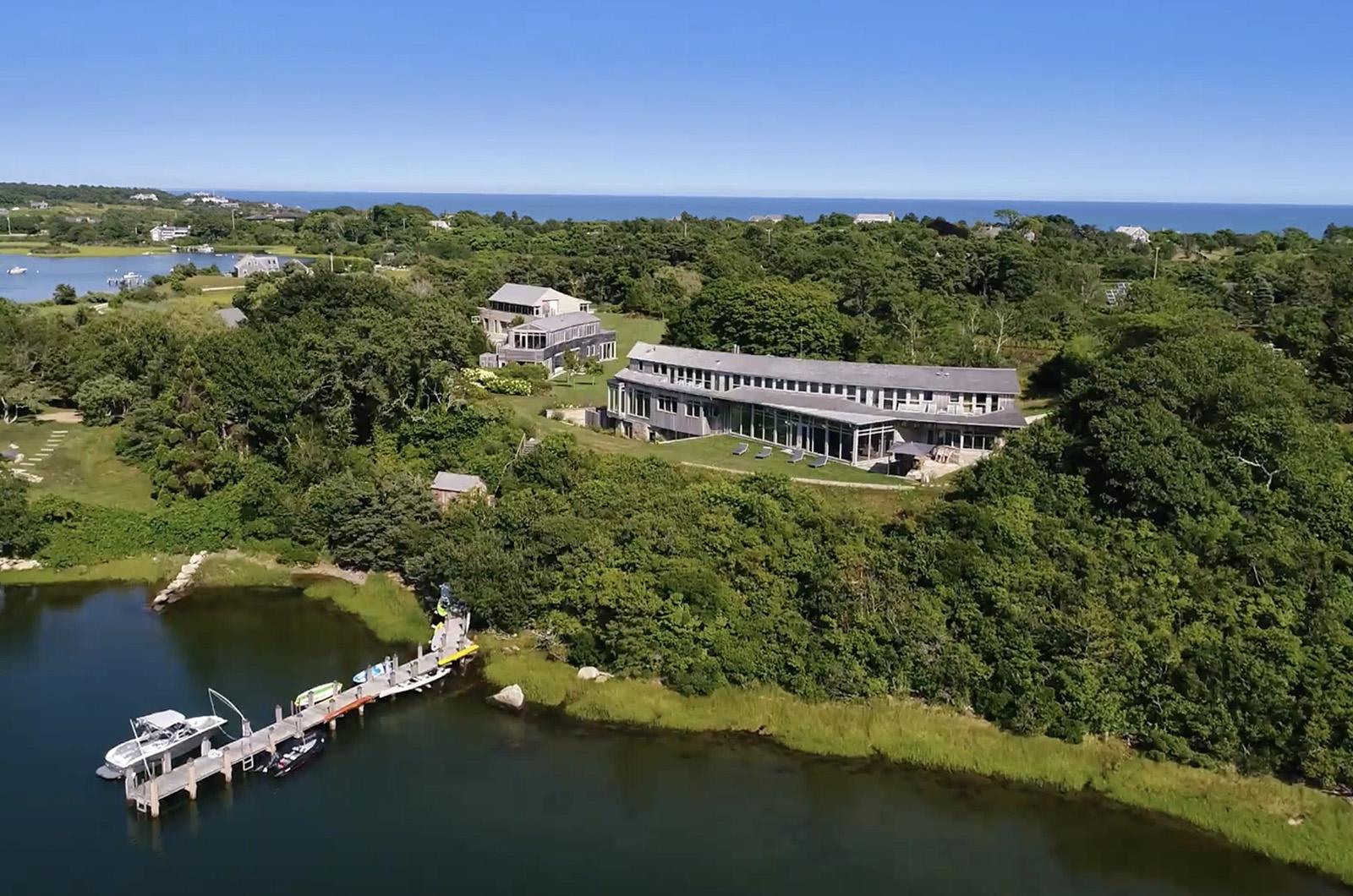Eleven bedrooms, 13 bathrooms, two guest houses, a private theater, an indoor heated pool, a 50-foot Italian yacht and a pickleball court on five acres with a view of Nashaquitsa Pond could all be yours to rent this summer, at the cost of $1 million for a four-week stay.
An imposing series of curved structures in gray wood and glass perched pondside in Chilmark, the newly-listed rental is the most expensive ever to be offered on the Vineyard, according to Sotheby’s International Realty.
The record-breaking price tag adds another chapter to a property which has already drawn major controversy since New York businessman Adam Zoia expanded it in 2012. Backlash on the project in Chilmark inspired a documentary film and the “big house bylaw,” a regulation limiting home size that passed at the 2013 annual town meeting.

Since its passage, the bylaw has been lauded by town residents and officials as a major step toward maintaining the town character of Chilmark. West Tisbury even passed its own big house bylaw modeled on Chilmark’s in 2022.
But for some Chilmark officials, the recent high-value listing of the Zoia property again highlights just how much the town has changed — and how much more work is yet to be done.
“I have said in many meetings that our Island is sinking under the weight of money,” said select board member Jim Malkin, in a statement to the Gazette. “A rental at this astounding figure is clear evidence of the ever-increasing income inequality that is eroding the culture and community of our town and Island.”
“This inequality,” he continued, “is making it increasingly difficult for our year-round population to continue to live and work in our community.”
Though extravagant mansion estates are far from new on the Vineyard, this property, located on 18 Point Inner Way, represents a new high for the Island rental market.
“It’s certainly the first of its kind, in my opinion, for this kind of rental,” said Sotheby’s listing broker Thomas Wallace. “Usually when someone has a house of this caliber, they simply don’t make it available for rental.”
Mr. Wallace said only the owner and his family had previously used the property, and their schedule this summer has them arriving in August. The property is available to rent for any four consecutive weeks May through July and September through October.
In addition to more than 10,000 square feet of floor space, a deep-water harbor and considerable pond front acreage, the house also includes a laundry list of luxury amenities.
“You can go on, and on and on,” Mr. Wallace said. “Whether it’s tennis or pickleball or a swimming pool or basketball, you know, all kinds of fun things.”
Included with the price of the rental, he said, is access the to the three boats moored on the property: a Mastercraft X26 motorboat, a Zodiac Open 7.0 speed boat, and a custom, 50-foot Novamarine yacht, equipped with five motors.
Renters will need to bring their own captain, Mr. Wallace said.
For town zoning board and former planning board member Chris Murphy, who was involved in the development of the big house bylaw, the house is a far cry from old-school Chilmark.
“What happened to the days when people wanted a little camp on the beach with sand on the floor and quahaugs for dinner they got themselves?” he lamented, in an interview with the Gazette. The change in rental tastes reflects a change in the town’s summer population, Mr. Murphy said.
“When I was a kid, the summer people that came, by and large, wanted to be part of the local community. They played baseball with the locals, they went to the beach where the locals went, and their dinner guests were local people,” he said. “At some point, the only people they really wanted to talk to were the other people from wherever the borough in New York is that they came from.”
According to Mr. Wallace, renters on the highest rungs of the market often enjoy the seclusion of a self-contained estate.
“Chilmark is a great place to retreat, and the privacy is a significant component to it,” he said.
In 2012, when Mr. Zoia expanded his compound with the addition of a building that now houses the pool, spa and gym, its highly-visible grandiosity was cause for alarm from Chilmark residents and neighbors, the latter of whom challenged whether such a structure was allowable.
“It stood out from its size and visibility,” said planning board member Janet Weidner, also heavily involved in the bylaw’s development. “If it wasn’t in such a visible spot, right on the pond, I don’t think it would have been noticed. So that kind of got the conversation started.”
Once the conversation got started, however, the planning board shifted to developing a bylaw to regulate future mansion-building. Though a similar bylaw in Chilmark failed in 1991, Ms. Weidner said they got considerable public support.
“Pollyanna-ish as it sounds, at the time we were doing this a few people stood up and said, ‘I’m proud to live in a town where people are concerned about the character of the town,’” she said.
The effort to create a bylaw also became the subject of a documentary from Martha’s Vineyard Film Festival founder Thomas Bena.
After an extensive public hearing process, the board settled on a final bylaw, which required a special permit from the zoning board of appeals for new houses over 3,500 square feet per three acres. The bylaw limits total living area to 6,000 square feet, with another 250 square feet allowed per additional acre.
The bylaw, which voters overwhelmingly approved, also required biennial reviews to examine the efficacy of the regulation, which Ms. Weidner said has been largely positive. The 2015 review, for instance, found a 40 per cent reduction in the average size of new residences in Chilmark after the bylaw, finding the average new residence had reduced from 4,360 square feet to 2,570.
“In brief,” wrote the most recent, 2021 report, “the ZBA and the Planning Board agree that the Residential Building Size Regulation bylaw appears to be working.”
But while the bylaw may have curbed the worst excesses of opulent mansion-building, the damage that extremely-high value rentals can have on the community continues to be a burden, Mr. Murphy said.
“There’s these incredible buildings with all sorts of services, that requires numerous staff…so what did the people building that house do for affordable housing?” he said. “If they are creating, essentially, three full-time, year-round jobs, then they ought to be supplying homes for three full-time, year-round families.”
Chilmark currently has their short-term rental tax, which applies to stays of less than 30 days, set at 4 per cent. Each four-week rental period of the Zoia property would net the town $40,000 dollars in revenue.
At town meeting this year, Chilmark voters will determine whether to increase the town’s short term rental tax to 6 per cent, the maximum allowed by the state. The state levies an additional 5.7 percent.
For Mr. Murphy, the effort to keep the Vineyard livable for more than the ultra-rich is a guiding light.
“I’m 77 years old, I’ve got children that live here…and I’ve got grandchildren that are here,” he said. “If they want to live here in their lifetimes, it would be nice to think we’d left them someplace it was worth living. So that’s what keeps me involved.”







Comments (42)
Comments
Comment policy »